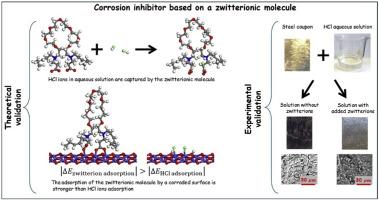两性离子聚合物作为高性能缓蚀剂:Ab-Initio量子洞察和含铁表面的实验验证
IF 3
4区 生物学
Q2 BIOCHEMICAL RESEARCH METHODS
引用次数: 0
摘要
提出了一种聚合物-两性离子缓蚀剂(PZCI),用于降低暴露于HCl酸性水介质中的原始或初始降解铁表面的腐蚀速率,并对其性能进行了量子理论和实验研究。利用密度泛函理论(DFT)研究了HCl在黄铁矿、赤铁矿、菱铁矿和纯铁等含铁表面的吸附,并与PZCI进行了比较。DFT预测PZCI的季胺和羧酸官能团通过预先捕获HCl来阻止HCl到达表面。同样,PZCI的羧酸氧与降解表面暴露的铁原子结合,完成后者的八面体氯配位,并通过排斥接近的氯阴离子来屏蔽它们。此外,由于烷基尾的碳双键C=C也由表面铁原子连接,PZCI的表面吸附得到加强。因此,预计PZCI必须在初始降解阶段有效地保护表面免受随后的腐蚀。在含PZCI和不含PZCI的HCl水溶液中对钢片进行了实验验证,发现PZCI能降低钢片的腐蚀速率。本文章由计算机程序翻译,如有差异,请以英文原文为准。

Zwitterionic polymers as high-performance corrosion inhibitors: Ab-Initio quantum insights and experimental validation for iron-containing surfaces
A polymeric-zwitterionic corrosion inhibitor (PZCI) to reduce the corrosion rate of pristine or initially degraded iron surfaces exposed to an HCl acidic aqueous medium is proposed, and its performance was both quantum-theoretically and experimentally investigated. The adsorption of HCl on iron-containing surfaces such as pyrite, hematite, siderite and pure iron was studied through Density Functional Theory (DFT) and compared with that of PZCI. DFT predicts that the quaternary-amine and carboxylate functional groups of PZCI prevent HCl from reaching the surfaces by capturing it beforehand. Likewise, the PZCI's carboxylate oxygens bind to the degraded surfaces' exposed Fe atoms, completing the octahedral chalcogen coordination of the latter and shielding them through repulsion of approaching chlorine anions. The PZCI surface adsorption is moreover strengthened because the alkyl tail's carbon double bonds C=C are also linked by surface Fe atoms. Consequently, it is predicted that PZCI must efficiently protect surfaces at initial degradation stages against subsequent corrosion. This prediction was experimentally verified on a steel coupon immersed in HCl aqueous solutions with and without lab-synthesized PZCI, and it was found that the corrosion rate was reduced when PZCI was used.
求助全文
通过发布文献求助,成功后即可免费获取论文全文。
去求助
来源期刊

Journal of molecular graphics & modelling
生物-计算机:跨学科应用
CiteScore
5.50
自引率
6.90%
发文量
216
审稿时长
35 days
期刊介绍:
The Journal of Molecular Graphics and Modelling is devoted to the publication of papers on the uses of computers in theoretical investigations of molecular structure, function, interaction, and design. The scope of the journal includes all aspects of molecular modeling and computational chemistry, including, for instance, the study of molecular shape and properties, molecular simulations, protein and polymer engineering, drug design, materials design, structure-activity and structure-property relationships, database mining, and compound library design.
As a primary research journal, JMGM seeks to bring new knowledge to the attention of our readers. As such, submissions to the journal need to not only report results, but must draw conclusions and explore implications of the work presented. Authors are strongly encouraged to bear this in mind when preparing manuscripts. Routine applications of standard modelling approaches, providing only very limited new scientific insight, will not meet our criteria for publication. Reproducibility of reported calculations is an important issue. Wherever possible, we urge authors to enhance their papers with Supplementary Data, for example, in QSAR studies machine-readable versions of molecular datasets or in the development of new force-field parameters versions of the topology and force field parameter files. Routine applications of existing methods that do not lead to genuinely new insight will not be considered.
 求助内容:
求助内容: 应助结果提醒方式:
应助结果提醒方式:


